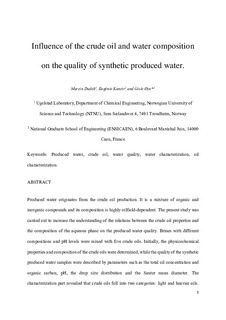| dc.contributor.author | Dudek, Marcin | |
| dc.contributor.author | Kancir, Eugènie | |
| dc.contributor.author | Øye, Gisle | |
| dc.date.accessioned | 2018-03-15T08:34:53Z | |
| dc.date.available | 2018-03-15T08:34:53Z | |
| dc.date.created | 2017-03-08T10:05:29Z | |
| dc.date.issued | 2017 | |
| dc.identifier.citation | Energy & Fuels. 2017, 31 (4), 3708-3716. | nb_NO |
| dc.identifier.issn | 0887-0624 | |
| dc.identifier.uri | http://hdl.handle.net/11250/2490609 | |
| dc.description.abstract | Produced water originates from crude oil production. It is a mixture of organic and inorganic compounds, and its composition is highly oilfield-dependent. The present study was carried out to increase the understanding of the effects of the relationships between the crude oil properties and the composition of the aqueous phase on the quality of the produced water. Brines with different compositions and pH levels were mixed with five crude oils. Initially, the physicochemical properties and compositions of the crude oils were determined, and the qualities of samples of synthetic produced water were described by parameters such as the total oil concentration, total organic carbon content, pH, drop size distribution, and Sauter mean diameter. Analysis of the characterization data revealed that the crude oils fell into two categories: light and heavier oils. Most parameters such as density, viscosity, total acid number (TAN), and composition reflected this division. A similar pattern was sustained for the water-quality analyses. Water produced with heavier crude oils generally contained higher concentrations of emulsified oil with the largest and most polydisperse droplets. Light oils had a tendency to create water-in-oil emulsions between the oil and water phases, which impeded the phase separation, resulting in less free water. The Sauter mean drop diameters were found to increase with the pH of the water phase. However, the presence of calcium at the highest pH decreased the droplet size and the amount of free water, compared to the results obtained using brine without divalent ions, in agreement with the interfacial role of naphthenic acids in crude oil emulsions. The results showed the significance of both the water and oil compositions on the quality of the produced water, which can lead to an improved fundamental understanding of the process for treating produced water. | nb_NO |
| dc.language.iso | eng | nb_NO |
| dc.publisher | American Chemical Society | nb_NO |
| dc.title | Influence of the Crude Oil and Water Compositions on the Quality of Synthetic Produced Water | nb_NO |
| dc.type | Journal article | nb_NO |
| dc.type | Peer reviewed | nb_NO |
| dc.description.version | acceptedVersion | nb_NO |
| dc.source.pagenumber | 3708-3716 | nb_NO |
| dc.source.volume | 31 | nb_NO |
| dc.source.journal | Energy & Fuels | nb_NO |
| dc.source.issue | 4 | nb_NO |
| dc.identifier.doi | 10.1021/acs.energyfuels.6b03297 | |
| dc.identifier.cristin | 1456543 | |
| dc.relation.project | Norges forskningsråd: 237893 | nb_NO |
| dc.description.localcode | © American Chemical Society 2017. This is the authors accepted and refereed manuscript to the article. | nb_NO |
| cristin.unitcode | 194,66,30,0 | |
| cristin.unitname | Institutt for kjemisk prosessteknologi | |
| cristin.ispublished | true | |
| cristin.fulltext | preprint | |
| cristin.qualitycode | 2 | |
